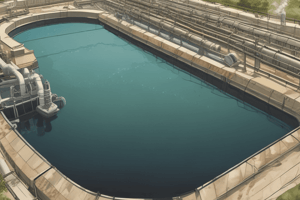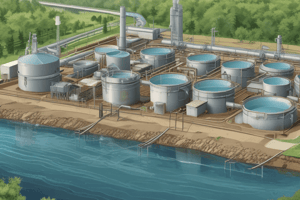Podcast
Questions and Answers
What is the purpose of the pretreatment process in a sewerage system?
What is the purpose of the pretreatment process in a sewerage system?
To remove large solid substances like metal cans, paper, and plastic
How is sludge removed from settling tanks in a sewerage system?
How is sludge removed from settling tanks in a sewerage system?
Using a scraper every few days
What is the role of activated sludge in the secondary treatment process?
What is the role of activated sludge in the secondary treatment process?
To remove organic wastes using aerobic bacteria
What happens to the biogas produced in digesters in a sewerage system?
What happens to the biogas produced in digesters in a sewerage system?
What is the purpose of the tertiary treatment process in a sewerage system?
What is the purpose of the tertiary treatment process in a sewerage system?
How does chlorination contribute to the treatment of wastewater in a sewerage system?
How does chlorination contribute to the treatment of wastewater in a sewerage system?
Where is the treated water released after the entire wastewater treatment process?
Where is the treated water released after the entire wastewater treatment process?
Sewerage systems carry wastewater from homes, hotels, factories, and other establishments to ______ plants.
Sewerage systems carry wastewater from homes, hotels, factories, and other establishments to ______ plants.
Pretreatment process involves removing large solid substances like metal cans, paper, and plastic using ______ or vertical bars.
Pretreatment process involves removing large solid substances like metal cans, paper, and plastic using ______ or vertical bars.
Settling tanks or sedimentation tanks allow sand, pebbles, and soil to settle, while solid waste settles at the bottom and floatable material ______.
Settling tanks or sedimentation tanks allow sand, pebbles, and soil to settle, while solid waste settles at the bottom and floatable material ______.
Sludge is removed every few days with a ______, while scum is skimmed off using a skimmer.
Sludge is removed every few days with a ______, while scum is skimmed off using a skimmer.
Secondary treatment process uses aerobic bacteria to remove organic wastes in an ______ tank.
Secondary treatment process uses aerobic bacteria to remove organic wastes in an ______ tank.
Biogas produced in digester can be used as ______ or to produce electricity.
Biogas produced in digester can be used as ______ or to produce electricity.
Tertiary treatment process uses chlorine to remove phosphorus, nitrogen compounds, and ______.
Tertiary treatment process uses chlorine to remove phosphorus, nitrogen compounds, and ______.
Light travels in a ______ line and follows rules in a mirror
Light travels in a ______ line and follows rules in a mirror
In water, reflections are distorted due to its ______ property
In water, reflections are distorted due to its ______ property
Reflections occur due to the change in direction of light when it hits a ______
Reflections occur due to the change in direction of light when it hits a ______
Reflections can provide valuable information about an object's ______ and properties
Reflections can provide valuable information about an object's ______ and properties
The text emphasizes the importance of understanding reflections in ______ and optics
The text emphasizes the importance of understanding reflections in ______ and optics
Electricity is a flow of ______ charge
Electricity is a flow of ______ charge
Energy is essential for our daily lives as it helps us meet our basic ______
Energy is essential for our daily lives as it helps us meet our basic ______
We can detect energy through sensors and the response of objects to ______
We can detect energy through sensors and the response of objects to ______
Just as the sun provides us with light during the day, we can use batteries and generators to provide light at ______
Just as the sun provides us with light during the day, we can use batteries and generators to provide light at ______
Light can travel in straight ______
Light can travel in straight ______
Flashcards are hidden until you start studying
Study Notes
- Sewerage systems carry wastewater from homes, hotels, factories, and other establishments to treatment plants.
- Wastewater undergoes treatment to remove physical, chemical, and biological contaminants.
- Pretreatment process involves removing large solid substances like metal cans, paper, and plastic using grids or vertical bars.
- Settling tanks or sedimentation tanks allow sand, pebbles, and soil to settle, while solid waste settles at the bottom and floatable material rises.
- Sludge is removed every few days with a scraper, while scum is skimmed off using a skimmer.
- Secondary treatment process uses aerobic bacteria to remove organic wastes in an aeration tank.
- Activated sludge, produced in secondary process and primary process, is transferred to digesters for decomposition by anaerobic bacteria.
- Biogas produced in digester can be used as fuel or to produce electricity.
- Tertiary treatment process uses chlorine to remove phosphorus, nitrogen compounds, and bacteria.
- Chlorination is a chemical process where chlorine tablets are added to kill germs.
- Treated water is released into other water sources.
Studying That Suits You
Use AI to generate personalized quizzes and flashcards to suit your learning preferences.




